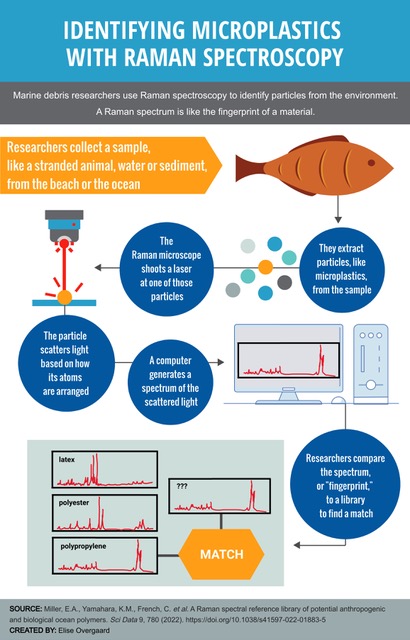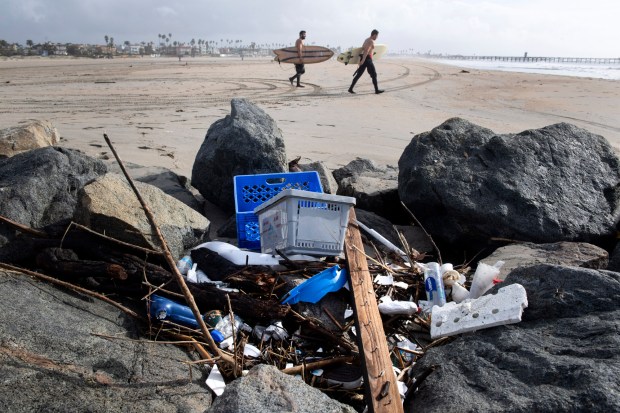We don’t often think of plastics as having “fingerprints.” But they do. And, as we continue to find microparticles in unexpected places — from local anchovy and seabird guts to the deepest trenches of the ocean — identifying those fingerprints is increasingly important.
Scientists at the Monterey Bay Aquarium and MBARI recently published an open-access library — a collection anyone can use for free — of the chemical fingerprints of microplastics and other particles that are commonly found in and around the ocean. Researchers can use the library to figure out what kind of plastics are entering the ocean, where they are coming from and what we can do to keep them out in the future.
Scientists estimate that more than 11 million tons of plastic are dumped into the world’s oceans every year — the equivalent of dumping a garbage truck full of plastic into the ocean every minute.
Those plastics get weathered and eroded down into microparticles the size of the tip of a ballpoint pen or nearly-invisible fibers. They are ingested by marine mammals, permanently entering the food chain. Study after study has confirmed that microplastics are a global problem. But to address it, scientists need to know which plastics are moving from land into water.
Collecting chemical ‘fingerprints’
“Identifying microplastics is actually not as easy as it sounds,” said Emily Miller, lead author of the study. “The most accessible tools scientists have — a microscope and our eyes — can be deceiving.”

The chemical fingerprinting technique, called “Raman spectroscopy,” is much more accurate.
It’s fairly straightforward — scientists isolate a piece of suspected microplastic from an animal gut or ocean water or sediment. They shoot a laser at it. The sample scatters the laser light in a characteristic way depending on how its molecules are arranged.
The microscope collects that scattered light and graphs it as a “spectrum.” It looks something like an ECG, with wavy lines and peaks at some points. And it’s unique to the material.
Chris French, the laboratory director at Eurofins S&N Labs and a study coauthor, said getting the spectrum, or the fingerprint, is the easy part. Figuring out what material the fingerprint belongs to is the challenge.
“You can take a spectrum but it’s practically meaningless unless you have a database to go back and do the fingerprint matching,” he said.
Researchers take a spectrum, compare it to libraries of the spectra of known materials and look for a match — just like a detective might compare a fingerprint from a crime scene to a database of human fingerprints.
The fingerprint tells you what the material is, which can point to a source.
“For example, polyethylene is commonly used in disposable water bottles, nylon is a common plastic used to make fishing line, and polyvinyl chloride is frequently used in agricultural irrigation,” said Miller. In some cases, a material could even be traced back to the company that made it.
But the libraries aren’t accessible to everyone.
“Nearly all spectra reference libraries are locked behind expensive paywalls,” said Miller.
Eurofins S&N Labs, a lab that specializes in identifying mystery particles, did the spectroscopy work for the study. S&N Labs has the equipment and the know-how, but even they have to pay for access to a paywalled spectral library. They pay almost $10,000 a year — a cost that gets passed down to their users.
S&N Labs has thousands of users across many industries. But they rarely see academic or marine debris researchers — probably because of the high costs. A single identification request can cost anywhere from $550 to $3,000. So if a researcher opens up a stranded marine animal and wants to know what all those plastic particles are inside, they have to be very selective about which particles they send in.
“It can be prohibitively expensive for research labs,” said French. “And, right now at least, research labs and universities are the only people who seem to be interested in characterizing” marine debris.
“Ocean plastic pollution is a global crisis and we need to remove the barriers so that researchers all over the world can help find solutions,” said Miller.
So the team created a library specific to marine debris that anyone can use. It’s only the second open-access Raman spectroscopy library to date.
What’s in the library?
To build the new library, the researchers tested samples with known identities: pristine plastics in new condition — things like coffee cup lids, electrical tape, pill bottles and styrofoam boxes — plus old, weathered things picked up from fishery environments and beaches — balloons, straws, bike innertubes, dock lines and a Lego tire.
Including the weathered polymers was an important advance for marine debris researchers. “You won’t find anything (in a commercial library) that has been sitting on the beach for three years,” said French.
Miller said when you’re looking at little microparticles collected from the environment they aren’t necessarily all plastic, so they also added biological things to the library — clam, crab and shrimp shells, purple sea urchin spines, kelp, and bone fragments from various marine species.
They scanned 79 materials in all. For each one, the team scanned the sample 100 times to produce 100 spectra, then averaged those scans together to get a single fingerprint. Then they added that fingerprint to the library for anyone to use.
The full library was published in Nature’s Scientific Data journal in December.
“It’s not a huge database that we helped create, but on the other hand, you won’t probably find more than 100 different types of polymers out on the beach,” said French. “I think for what its intended use is it’s a very comprehensive database.”

Matthew Savoca, a postdoctoral scholar at Stanford’s Hopkins Marine Station in Pacific Grove who was not involved in the study, commented: “If we’re going to mitigate this issue we need to figure out what the main sources are.”
Savoca studies how organisms interact with their environments and the human impact on those environments. He recently published a study showing that whales off the coast of California coast eat up to 10 million pieces of microplastics a day.
Savoca said including weathered materials was the study’s big, important advance. “What you’d find in the environment are materials that are degraded and fragmented and weathered,” he said. “The open-access part is nice, but I would argue that the libraries that exist are not super realistic to what you’d find in the real world, and this is bringing us closer to what you’d find in the real world,” said Savoca.
The Monterey-based researchers plan to use the library to identify particles pulled from the deepest parts of the Monterey Bay. The ultimate goal: keeping plastic out of the ocean in the first place.
“Once we have these plastic identities, we can trace the source of the pollution, and finally we can begin to manage the pollution pathway that enters the ocean,” said Miller.
Some interventions and management strategies have already begun to work.
States with “container deposit legislation,” or “bottle bills,” have much smaller percentages of beverage containers in their marine debris, based on data from NOAA’s Marine Debris Program. In other words, regulating specific plastics does help to keep them out of the ocean.
Miller hopes that more labs will continue to create and add to open-source libraries like this one. As libraries grow, scientists will have to standardize things like data collection and processing protocols so that the spectra are comparable and useful.
“The microplastics research community is in the beginning phase of making this type of research accessible to all,” she said. “We are putting this open-source library out into the world for others to use, but it is only one step. We need other community members to continue to contribute spectral libraries.”
The field of studying microplastics in the environment only emerged over the last decade, but it’s growing at a very rapid rate. “The community is growing so quickly that more and more people are going to find this useful over the coming months and years,” said Savoca. “I think it’s great that people in Monterey Bay are doing this work because it’s a really great system to study this problem in.”
